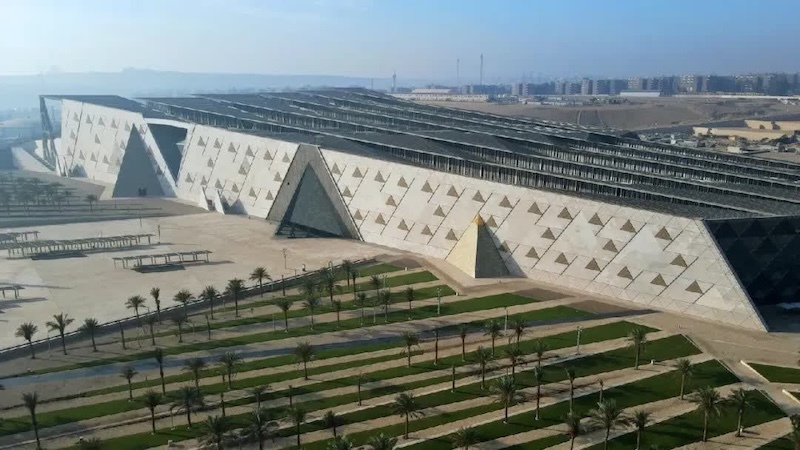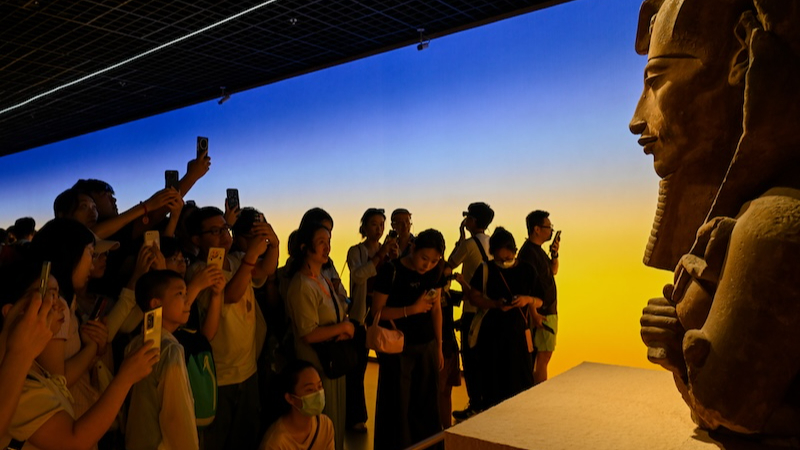

The exhibition is planned from the perspective of the descendants of ancient civilizations, highlighting the mutual learning of civilizations
The Shanghai Museum's "Top of the Pyramids: Ancient Egyptian Civilization Exhibition" will display more than 800 cultural relics in total. The exhibition will unfold independent narratives through three sections: "The Kingdom of the Pharaohs", "The Secret of Saqqara" and "The Age of Tutankhamun", interpreting the profound connotation of ancient Egyptian civilization from different angles. What is particularly rare is that it is not a simple introduction exhibition, but an ancient Egyptian civilization exhibition independently curated by a Chinese team of experts. "The exhibition will run through the research results of Chinese Egyptologists, and select representative exhibits based on our exhibition theme and curatorial ideas, from the perspective of historical, academic and artistic value." Chu Xiaobo, director of the Shanghai Museum, said at the press conference in the morning.

The Three Great Pyramids of Giza, Egypt
Yan Haiying, chief curator of the exhibition and professor at Shanghai International Studies University, also gave an in-depth interpretation of the curatorial ideas and highlights of the exhibition.
Why is the exhibition named "Top of the Pyramid"? Yan Haiying said that the name of the exhibition contains some symbolic meanings. As two ancient civilizations, China and Egypt have a long history and rich cultural relics. These cultural resources are being transformed into cultural achievements shared by the general public in modern society. From these perspectives, China and Egypt are both at the "top of the pyramid". "Top of the Pyramid" not only expresses the dialogue between the two ancient civilizations, but also a dialogue between the present and the past. As the curator of the exhibition, he planned this exhibition from the perspective of "the descendants of the ancient civilizations looking at the past history".
Yan Haiying said that the current "Egypt fever" is continuing to heat up, but the Chinese public's understanding of Egyptian cultural relics is actually not comprehensive enough, and is more limited to Egyptian pyramids, golden masks, mummies, etc. This is caused by some objective reasons. Compared with the rich collections of Egyptian cultural relics in major museums in Europe and the United States, China has no collection of ancient Egyptian cultural relics. Egyptology is a discipline created by Westerners, and the discourse power of Egyptology has long been monopolized by Western countries such as Britain, France and Germany. Both Egypt and China started research on it relatively late, which led to the Chinese public's understanding of ancient Egypt being based on the research of Western scholars and the image of Egypt constructed by popular culture.

The unpacking scene of the "Painted Humanoid Coffin" (Photo by Zhu Weihui of The Paper)
"In fact, there are many more valuable cultural relics in Egypt waiting for the Chinese public to understand. This is also the responsibility and obligation that scholars and large museums like the Shanghai Museum should shoulder." Yan Haiying said, for example, many of the Egyptian museums participating in the exhibition have generously loaned their latest and most important cultural relics to China, especially in the "Secrets of Saqqara" section, which exhibits the latest archaeological discoveries in the Saqqara area. After being excavated from the archaeological site, they were simply cleaned in the warehouse and then sent to Shanghai for exhibition. It can be said that the Egyptian government has broken precedent by loaning new archaeological discoveries to Shanghai.
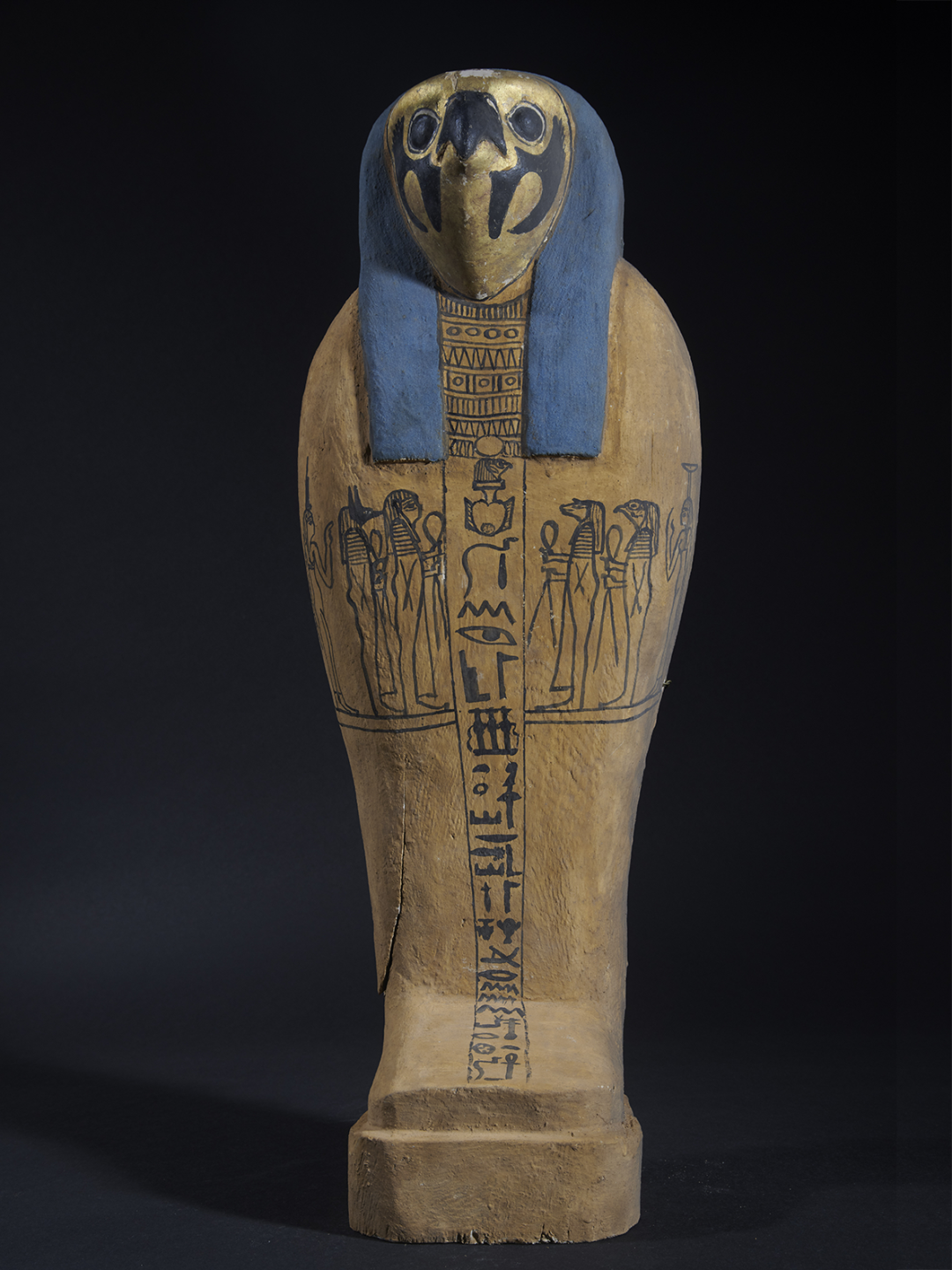
Painted wooden coffin model in the shape of an eagle head, wood, pigment, Late Egypt (664-332 BC), Egyptian National Museum
"The Kingdom of the Pharaohs" attempts to tell the history of Egypt from a Chinese perspective. "Egypt and China are both ancient civilizations, but the difference is that they are in different environments. Egypt is in the Mediterranean civilization circle and has a symbiotic relationship with other ancient civilizations in the world, while Chinese civilization itself is a highland, so it can be said that it is the same type but in different environments. We want to tell its history from a comparative perspective," said Yan Haiying.

Nefertiti relief, limestone, 18th Dynasty (1550-1295 BC), Egyptian National Museum
In the context of historical development, ancient Egypt entered the imperial era in 1500 BC and faced a huge transformation, from its previous relatively isolated state to the collision and integration with civilizations in other regions. It also faced turmoil and transformation internally. The era in which Tutankhamun lived was such a special period of transformation, so it is natural to enter the section of "The Era of Tutankhamun".
"So the special topic of Tutankhamun that we present is not to present the treasures unearthed from Tutankhamun's tomb, but to use the artifacts related to Tutankhamun to see what Tutankhamun, as a young pharaoh, did in his special era, as well as the turbulent era he lived in."

Cultural relics exhibition site
The Underrated Giant Stone Sculpture of Tutankhamun
At the press conference in the morning, the museum also revealed some of the most important exhibits. In addition to the giant sculptures of Akhenaten and Tutankhamun, the tallest exhibit in this exhibition, the 2.4-meter-high stone sculpture of Merneptah from the Luxor Museum, will be placed outdoors for exhibition and will be protected by glass display cases. In addition, there are the "Lion Goddess Statue", "Amun's Wife", "30th Dynasty Noble Sarcophagus", "Anubis Statue" from the Suez Museum, the King Statue from the Sohag Museum, and the Ancient Egyptian Stele from the Sackler Museum.
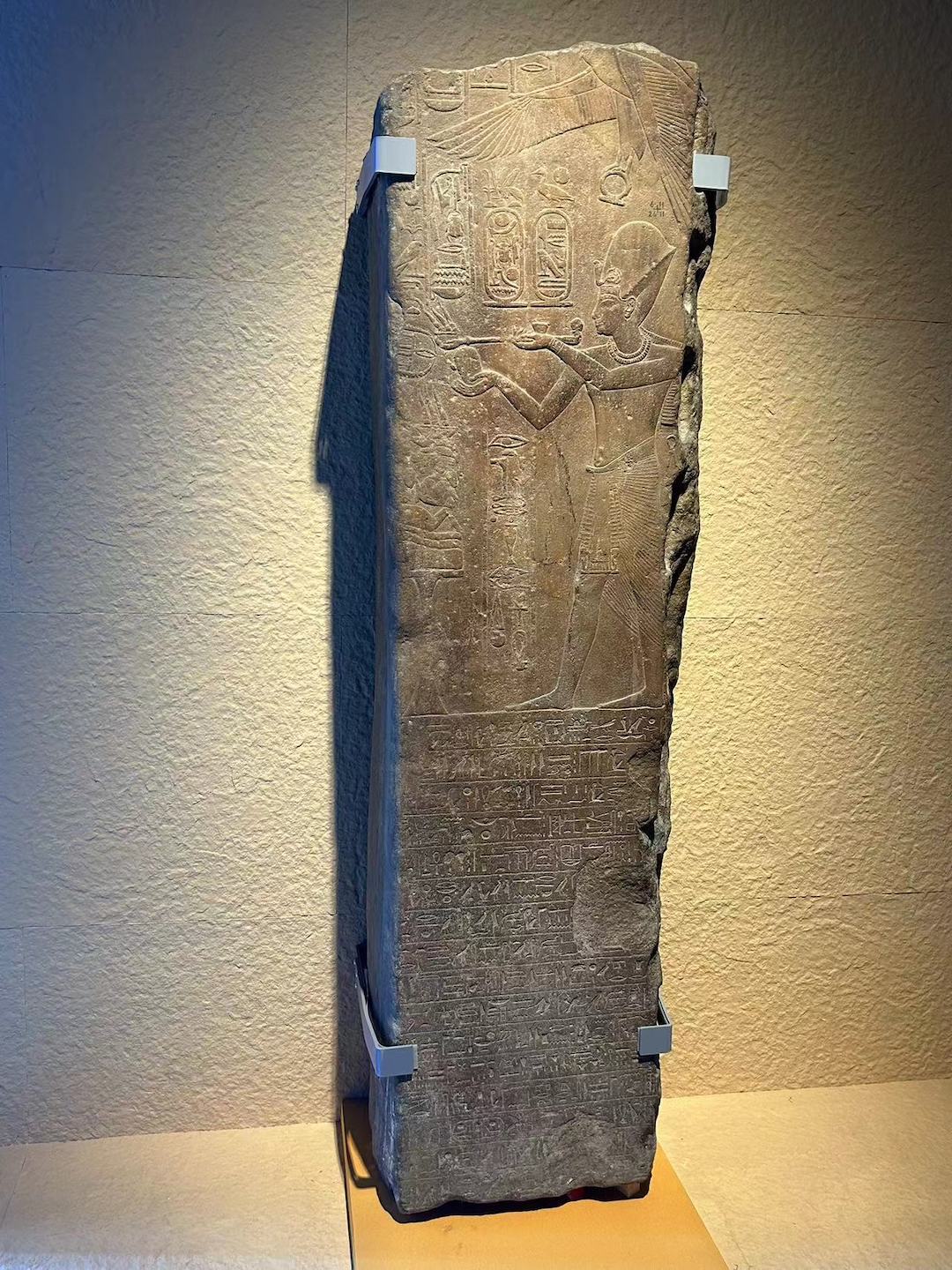
Cultural relics exhibition site
A reporter from The Paper saw that at the exhibition site of the briefly opened "The Age of Tutankhamun" exhibition hall, the giant stone sculpture of Tutankhamun and the sculpture of Pharaoh Akhenaten were both in place, with the sculptures of the father and son facing each other across the exhibition hall.
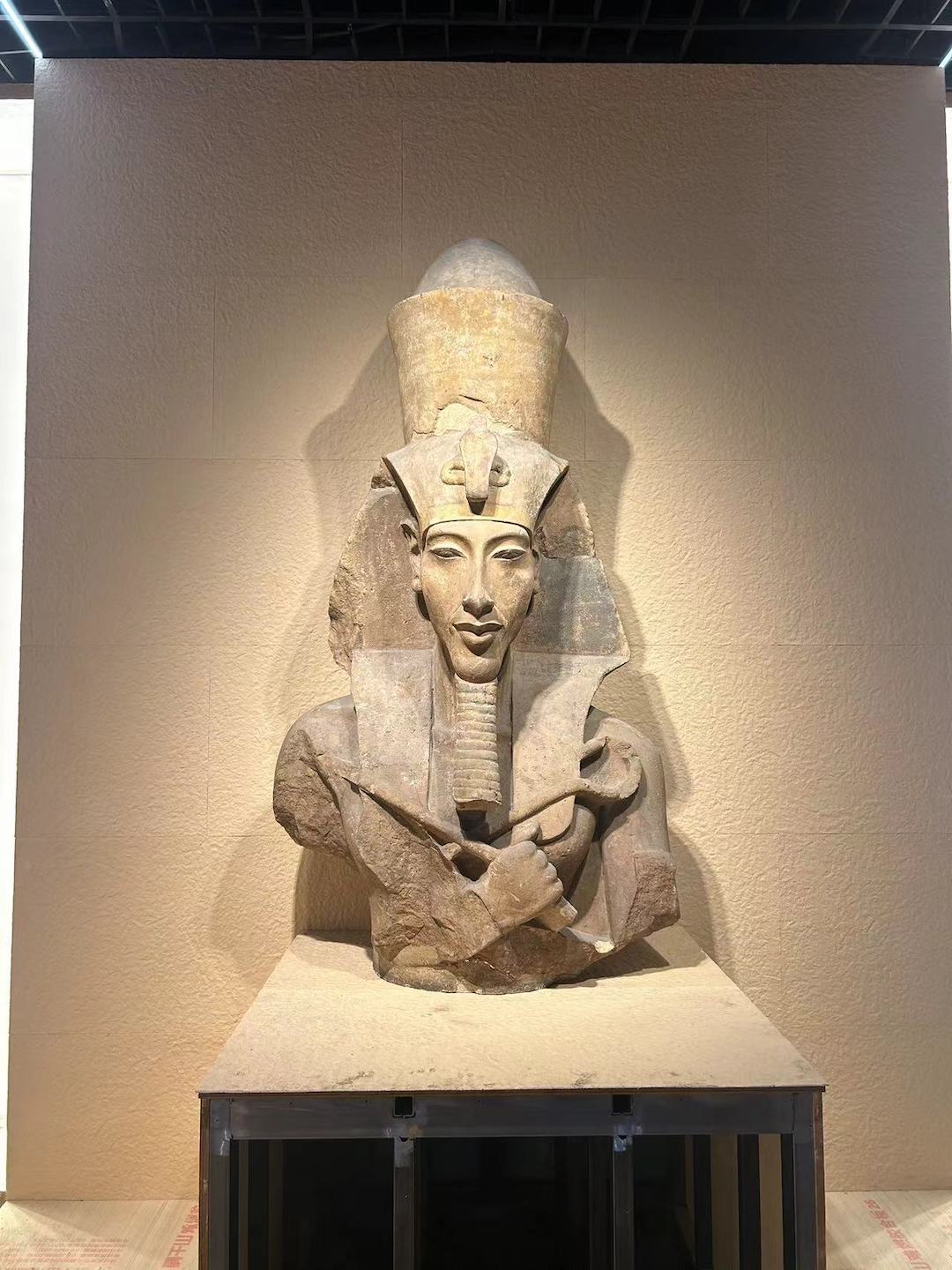
Akhenaten
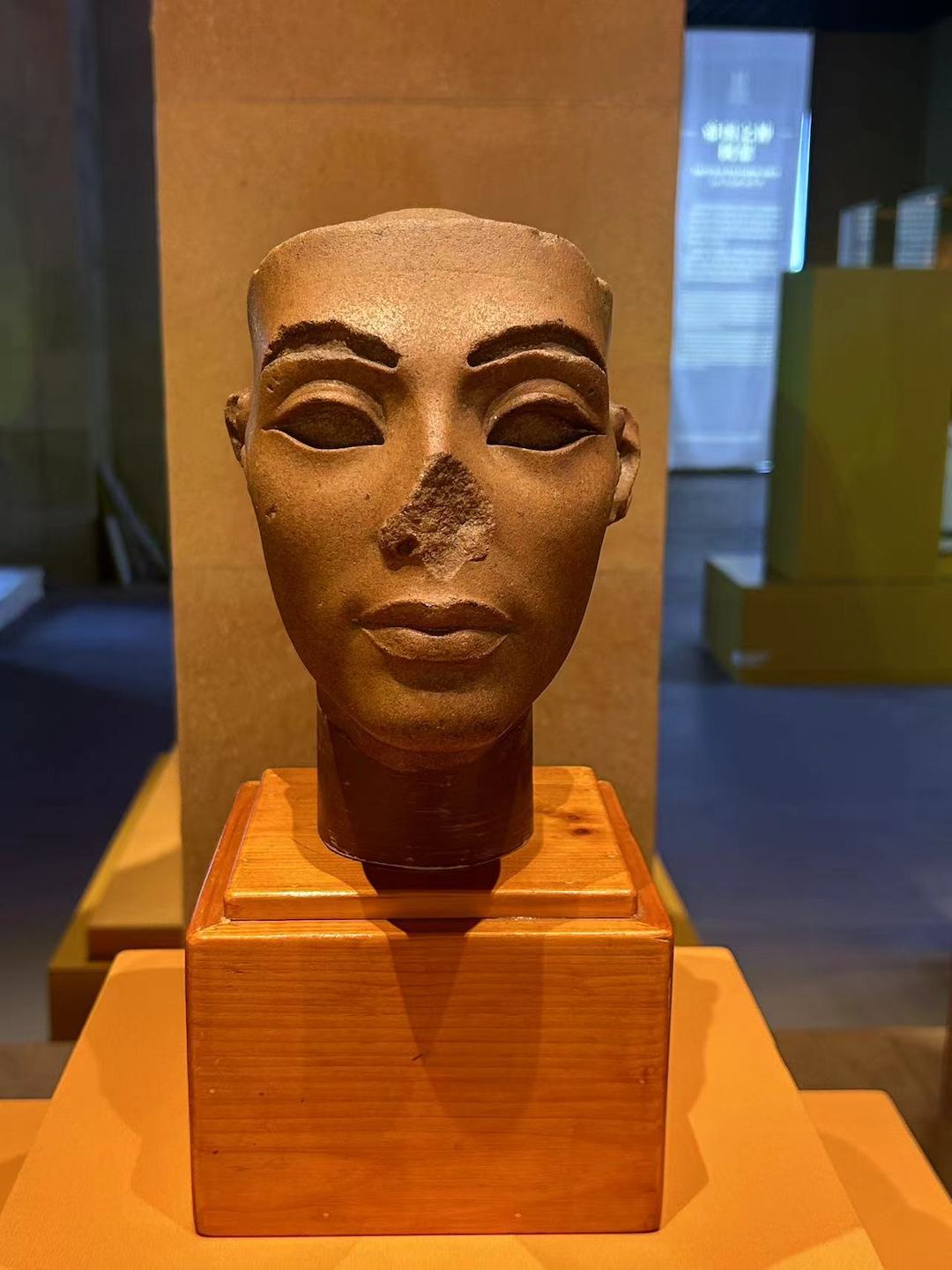
Nefertiti head
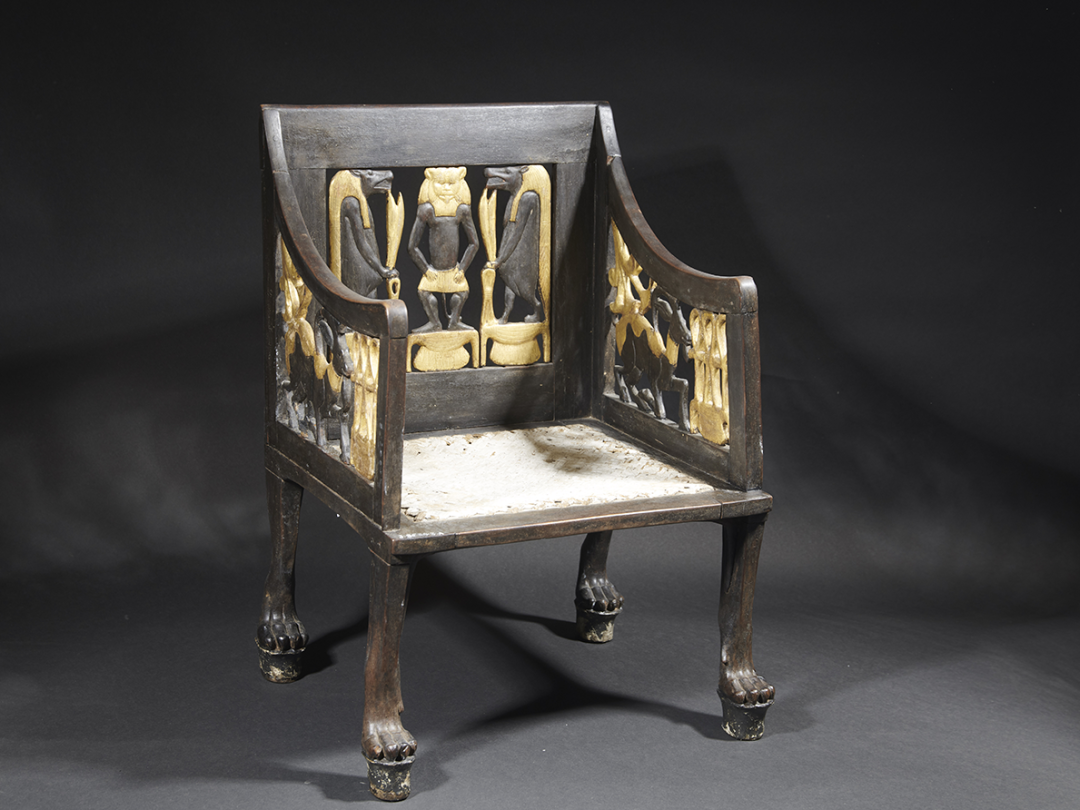
Chair with the image of the god Bes, wood, pigment, silver, 18th Dynasty (1550-1295 BC), National Museum of Egypt
The exhibition hall "The Age of Tutankhamun" brings together several important historical figures in ancient Egypt, including a giant statue of Tutankhamun, statues of his father Akhenaten, his mother Nefertiti, his parents, a chair used by his grandmother, and funerary objects of his grandfather. It can be said that this exhibition hall brings together the cultural relics of Tutankhamun's entire family. The reason for using these cultural relics is to tell the story of this special period in the history of ancient Egypt that his family experienced. During this period, the first sprout of monotheism appeared in the history of ancient Egypt. Tutankhamun's father Akhenaten initiated a reform from polytheism to monotheism. After Akhenaten's death, his new religion soon ended, and Tutankhamun returned to tradition. "From the promotion of monotheism to the end of the return to tradition, this family has undergone a major change. Tutankhamun is at this time point of returning to tradition, so the story behind this exhibition hall is very rich." Yan Haiying said.

Tutankhamun statue
Xue Jiang, a researcher at the Institute of World Art History of Shanghai International Studies University, believes that the giant sculpture of Tutankhamun in the exhibition hall is a cultural relic that is seriously underestimated by the Egyptology community. It is one of the few sculptures of Tutankhamun left over from the reign of Tutankhamun and is "extremely exquisite and shocking."
"Tutankhamun is a very special pharaoh in Egyptian history. He was a young pharaoh who succeeded to the throne in childhood but died in youth. Therefore, many people think that Tutankhamun was a pharaoh who did nothing. However, this young pharaoh actually made great contributions. First, he broke the monotheism founded by his father and returned to traditional beliefs. Secondly, he rebuilt the order of ancient Egypt." Xue Jiang said. Specifically, the statue of Tutankhamun is also a change from the old-fashioned and stylized statues of pharaohs in the Old Kingdom and the Middle Kingdom. It presents a perfect combination of realism and ritual. "From the original divinity to humanity, although the face of the sculpture is incomplete, the shape is lifelike like a real person."
Link:
The first "one-stop cultural tourism experience new scene"
1. Bring your pet cat to the exhibition: Museum's "Meow" Night
In the distant past of ancient Egypt, the cat god Bastet was regarded as a symbol of protection and spirituality. The Egyptians' worship of the cat god transcended the boundaries of time and space, which coincides with people's love for "cats" today. In order to complement this exhibition, the Shanghai Museum will regularly hold the "Museum Wonderful 'Meow' Night" event. The first event is scheduled for the evening of July 27 (held every Saturday night, a total of 10 events). Visitors are welcome to bring their pet cats to visit the exhibition - this is a first in comprehensive museums around the world.
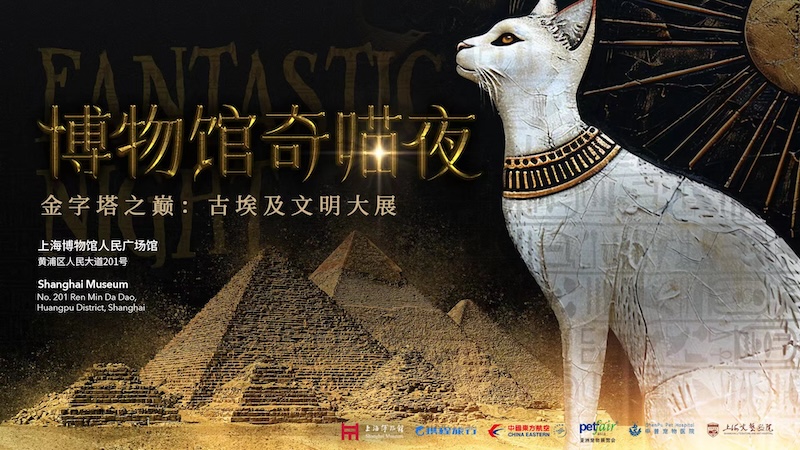
Night at the Museum
While visiting the exhibition, visitors can take photos with their pets in the cat temple area of the "Secrets of Saqqara" exhibition hall, and experience projects such as "Traveling with Pets in Egypt", "Photographing with Giant Cat Sculptures", "Cat Paw Interaction" and "Cat Paw Message". Each visitor who participates in the event will receive an exclusive customized "Meow" Night limited refrigerator magnet, and visitors with pet cats will have the opportunity to receive exclusive cat cultural and creative gifts and feel the blessings from ancient civilization.
To ensure the smooth running of the event, the Shanghai Museum has purchased an event insurance for each visitor of the Cat Night and specially invited qualified surgeons to be on-site to deal with any accidents of visitors. In cooperation with experienced professional pet medical institutions, the museum has arranged for practicing veterinarians to be on-site and pet cat medical service vehicles to be parked outside the museum for emergency treatment. The museum staff will receive professional training on pet cats, and the operation will be assisted by pet industry personnel.
In addition, the museum also provides cat-friendly devices, cat storage, cat mood stabilizers and cat strollers and other thoughtful services. After each activity, the entire museum will be thoroughly disinfected, sterilized and deodorized to ensure normal opening for visits the next day.
Tickets for the Wonderful Night of Meow need to be purchased separately. Tickets will go on sale at 12:00 on July 19 and will be sold uniformly by Ctrip.com. Visitors can search for "Shanghai Museum" on the Ctrip.com app and click to enter and purchase. For more tips on visiting the Wonderful Night of Meow, please pay attention to the detailed visiting guide released by the Shanghai Museum official platform.
In order to facilitate visitors from afar to travel with their pets, Shanghai Expo and China Eastern Airlines are actively trying to promote the launch of pet flights. Visitors who plan to go to Shanghai to participate in the "Meow Night" event in the near future can also arrive in advance by checking in their pets. In addition, around People's Square, there are many hotels that provide pet-friendly services, such as OPARTMENT Far East Hotel, etc., and everyone can check and book through the Ctrip Travel App.
2. Combination of Virtual and Real: Immersive Experience of “The Lost Pharaoh”
On the second floor, in the former Chinese Ancient Ceramics Museum and the former Temporary Building Exhibition Hall, the Shanghai Museum will also join hands with the well-known domestic immersive exploration experience brand "Boxin Universe" to create a universal exhibition hall for the ancient Egyptian civilization exhibition - "The Lost Pharaoh: The Immersive Exploration Experience Exhibition of the Pyramid of Khufu". Through the top virtual reality technology, the audience will experience this phenomenal VR exhibition that has swept the world in a 45-minute "time and space travel". Tickets for the VR exhibition must be purchased separately, and the audience can purchase tickets through the "Boxin Universe" applet or on-site.
3. Day and night, waterfront linkage - sea and land travel
On the occasion of the launch of the first "Shanghai Summer" International Consumption Season, the Shanghai Museum will work with well-known Shanghai companies to launch a variety of cultural and tourism activities to create a new panoramic exhibition experience by land and sea. After viewing the exhibition during the day, visitors can go to the Huangpu River at night to enjoy the beautiful scenery.
1. Shanghai Expo Cruise "From the Nile to the Huangpu River"
During the "Top of the Pyramids: Ancient Egyptian Civilization Exhibition", the Shanghai Museum will join hands with the luxury cruise ship under Yuexing Culture and Tourism to specially create the "Shanghai Museum" ancient Egypt theme flight "From the Nile River to the Huangpu River". From the pier to boarding, from the theater to the deck, it will creatively incorporate magnificent ancient Egyptian elements and immersive performances. Through color vision, spatial layout, art installations, interactive experiences, etc., it will create an ancient and mysterious ancient Egyptian atmosphere, and work together with the Shanghai Museum's waterfront to interpret the cross-time and space dialogue of ancient civilizations, creating a new business card for the Magic City's immersive river cultural tourism.

Shanghai Expo Cruise
2. Double-decker buses, running in both directions
In order to facilitate the travel of visitors between the People's Square Pavilion and the East Pavilion, the Shanghai Museum cooperated with Shanghai Bus Fourth Public Transportation Co., Ltd. of Jiushi Group to open a convenient customized bus route on the joint opening days of the two pavilions (Wednesday to Sunday). It is now in operation. The specific information is as follows:
It runs from Wednesday to Sunday and statutory holidays. During the period from 11:00 to 15:00, two double-decker buses depart from the People's Square of Shanghai Museum and the East Building of Shanghai Museum in both directions at 11:00, 12:00, 13:00, 14:00 and 15:00 respectively.
In addition, there are two last double-decker buses for the two museums. One bus departs from the Shanghai Museum's People's Square at 17:00, and the other departs from the Shanghai Museum's East Hall at 16:30. Both end at the Bund's Shilipu Pier, connecting with the "Shanghai Museum" Pujiang cruise ship.

double decker bus
3. “Going to Ancient Egypt” Shanghai Museum Subway Train
In order to create an atmosphere of "the whole city seeing the exhibition", the Shanghai Museum has set up Egyptian exhibition theme light boxes in the subway stations near the People's Square Pavilion and the East Pavilion. A special train "Top of the Pyramids" on Metro Line 2 is about to depart, and we look forward to meeting more visitors.

"Going to Ancient Egypt" Shanghai Museum Metro Special Train
In conjunction with this exhibition, thousands of cultural and creative products will be launched through lottery, and diversified experiences will be upgraded, including free mini-games, fun in the ancient Egyptian Cat Temple, new cultural and creative products, bringing the Egyptian exhibition home, cultural activities such as cultural and creative products on the tip of the tongue, study tours, interpretation services, a scripted tour "The Secret of Saqqara - The Last Cat God Festival", and official raffles by the Egyptian Tourism Authority and EgyptAir.
